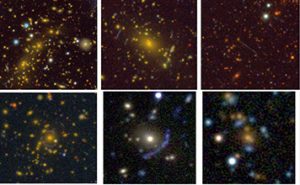
Photo: Courtesy of DES. Examples of strong lensing systems imaged in the DES science verification (SV) data. Previously known strongly lensed, bluish-colored arcs are visible in the DES images of three rich galaxy clusters. Top row, from left: Bullet Cluster, RXC J2248.7-4431 and El Gordo. A nearly complete Einstein ring is visible in another cluster lensing system (bottom left), which was previously found by Fermilab scientists.. Finally, two new candidate systems discovered in the DES SV data are also shown: one with a giant blue arc (bottom middle) and one with multiple blue images (bottom right).`
The Dark Energy Survey collected more than 34,000 exposures during its science verification (SV) phase, from November 2012 to February 2013. It also began its first official season of observations on Aug. 31. Among the millions of astronomical objects imaged by DES so far, there are rare instances of “strong lensing” systems, where the effects of general relativity, Einstein’s theory of gravity, are demonstrated in visually striking fashion.
When a foreground “lens” object is by chance very closely aligned on the sky with a much more distant background “source” object, the light from the source may be significantly deflected as it passes by the lens, due to the gravity of the lensing object’s mass. This strong lensing effect leads to big distortions in the appearance of the source object: An otherwise faint and fuzzy single distant background galaxy may be transformed instead into a long bright arc, maybe into multiple blue knots or, in the rarest cases, into a so-called Einstein ring (see figure).
This wide variety in appearance of strongly lensed images is a consequence of the complexities of the lensing mass, which can range from an individual galaxy to a rich cluster of many galaxies, together with the much more massive dark matter halos in which the (luminous) galaxies reside. Studies of strong lensing systems can thus reveal to us properties of the distribution of dark matter that accompanies galaxies and galaxy clusters. Moreover, in addition to galaxy clusters, weak lensing, large-scale structure and supernovae — the four primary dark-energy probes used by DES — strong lensing may ultimately provide yet another way to study dark energy. For example, cosmological parameters, including dark energy, will affect the abundance and frequency of strong lensing systems and hence influence how many such systems we’ll find in DES.
Indeed, one of the challenges of using strong lensing systems for cosmology is to find large numbers of these rare systems, but the DES is well suited for this, given both its large sky coverage and good imaging depth. Ultimately, automated methods will be employed to search for strong lensing systems within DES, but we have already found a number of good candidate systems in the DES SV data (see figure), through meticulous visual inspections of DES images by DES scientists and students, including in particular local area high-school students mentored by Fermilab scientists. As DES progresses, we expect to discover hundreds of strong lensing systems and will use them to further study and constrain the properties of dark matter and dark energy in the universe.
You can view recent images taken by the Dark Energy Survey at the new site Dark Energy Detectives.
– Huan Lin









